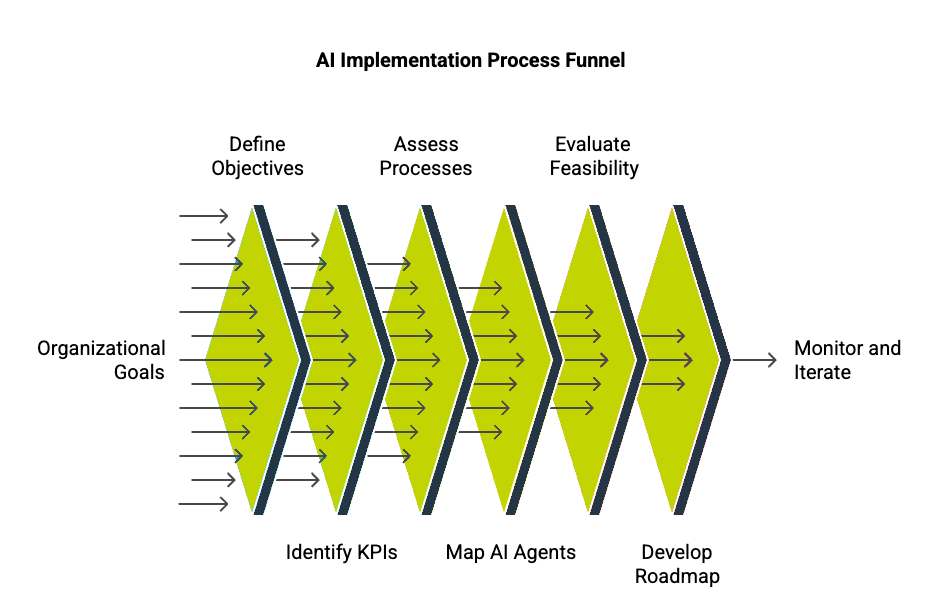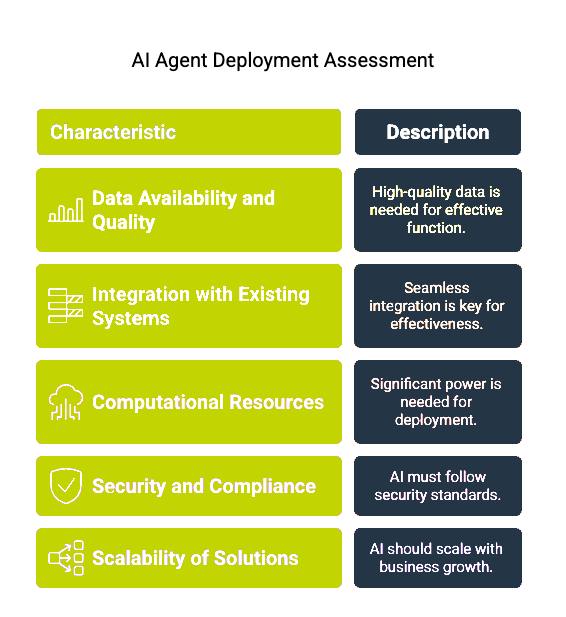Understanding AI Agents & Their Impact Across Your Organization
Discover how to choose and implement the right AI agents for your business needs, with real-world examples and best practices.
AI agents are software-based entities designed to carry out tasks, make decisions, and interact with digital environments in ways that mimic human-like behavior or improve on it.
What sets them apart from general artificial intelligence (AI) is their specificity: an agent operates with a defined goal, a set of inputs, and the ability to act autonomously or semi-autonomously based on what it perceives.

While traditional AI models might offer suggestions or generate content, agents are designed to follow through on actions, whether that means routing a support ticket, developing a product forecast, or optimizing inventory across multiple warehouses.
For mid-sized enterprises, this evolution has several real implications. AI agents aren’t theoretical anymore; they’re embedded in widely used platforms such as Microsoft 365, assisting with tasks that range from interpreting customer data to managing field operations.
From an executive lens, understanding the distinctions between agent types is more than academic. It’s the difference between a successful, scalable deployment and a project that burns through budget without returning measurable results.
Selecting the wrong type, or misjudging how it integrates into workflows, can stall adoption or create maintenance burdens that outweigh the upside. To help guide effective decision making, this guide breaks down the current environment surrounding AI agents in practical, functional terms.
01
Chapter 01
Part 1: A Deep Dive into AI Agent Types
AI agents are not one-size-fits-all, and they can vary widely in how they function, the problems they address, and the level of complexity they bring into an organization. For operations directors and other enterprise leaders, actually understanding these distinctions is essential for selecting the right tool for the job at hand.
The goal isn’t to implement AI for novelty’s sake, but to deploy the type of agent that directly supports a measurable business outcome.
1. Predictive AI Agents
Predictive AI agents are designed to anticipate future outcomes by analyzing historical and real-time data.
Machine learning enables these agents to detect large-scale patterns and insights that would be hard for people to spot manually. They generate forecasts across a range of domains, such as demand fluctuations, customer behavior, equipment failure risk, and financial performance.

The underlying engine of a predictive agent often includes regression models, time-series analysis, or more advanced ensemble learning techniques. These agents can assess thousands of variables simultaneously, ranging from weather conditions and economic indicators to past purchase patterns, and produce probabilistic estimates or confidence scores for future events.
Another defining capability is real-time risk detection. These agents can flag anomalies or early warning signals before a problem escalates. For instance, in supply chain operations, a predictive agent may detect potential disruptions in inbound shipments based on weather data or vendor behavior and suggest preemptive adjustments.
Predictive agents can refine their models over time by continuously ingesting new data, which allows them to adapt to shifting conditions in markets, consumer behavior, or operational inputs. The result is a decision-support layer that strengthens forecasting precision and response agility across multiple functions.
Many executives turn to predictive agents because of their ability to support better planning and reduce uncertainty. Instead of making decisions based on averages, gut instinct, or outdated historical reports, teams gain access to future-oriented insights that are grounded in live data.
It enables more proactive and precise actions, whether that’s reallocating resources, adjusting production schedules, or targeting the right customers with the right message at the right time.
In operations and finance, predictive agents can drive significant cost savings. For example, by improving inventory forecasts, companies reduce overstocking (which ties up working capital) and minimize stockouts (which result in missed sales). In many cases, even modest improvements in forecast accuracy translate to major financial impact at scale.

Another benefit exists in strategic planning. Forecasts generated by these agents support scenario modeling and what-if analysis, helping leaders simulate how different decisions might play out, which strengthens budgeting cycles and aligns cross-functional plans more tightly. For operations directors, predictive agents provide the data foundation for more reliable planning, fewer surprises, and smoother execution.
Quick wins are also a common benefit that organizations can enjoy. Because predictive agents often apply to well-documented use cases, like sales forecasting, churn prediction, or maintenance scheduling, enterprises can see value within months, provided the right data infrastructure is already in place.
Predictive AI agents are especially impactful in departments where future outcomes drive daily operations. In finance, they’re used for budget forecasting, cash flow prediction, and risk modeling.
Supply chain functions rely on them to forecast demand across product categories, manage inventory levels, and plan logistics. In maintenance, they support predictive maintenance by identifying equipment likely to fail before it happens, helping to schedule service more efficiently and avoid unplanned downtime.
In marketing and customer analytics, these agents forecast campaign outcomes, model customer churn, and predict customer lifetime value. It helps teams shift from reactive to proactive engagement strategies, optimizing resource use and maximizing return on spend.
A widely cited use case for predictive AI at scale comes from Walmart, the world’s largest retailer.
With millions of SKUs and a global supply chain, Walmart needed to improve how it forecasts product demand across stores. Traditional forecasting approaches couldn’t keep up with the complexity introduced by local events, seasonal trends, promotions, and shifting consumer preferences.

To address this, Walmart deployed predictive AI models developed by Blue Yonder. These agents ingest a vast array of variables, including weather data, historical sales, local events, and real-time demand signals, to generate store- and SKU-level forecasts. These predictions feed directly into Walmart’s inventory and ordering systems, enabling smarter replenishment decisions that are customized to each store’s needs.
The results have been significant. Walmart reduced both overstock and stockouts, leading to better shelf availability and fewer markdowns. Store managers reported fewer manual adjustments, as the AI-driven forecasts handled planning with greater precision.
While Walmart hasn’t disclosed exact financial gains from the initiative, internal reporting highlighted improved customer satisfaction and inventory cost savings amounting to millions of dollars.

Discover how Orases helped Spectrum Science save 20+ hours weekly by automating their data management processes and delivering accurate, real-time operational insights.
2. Generative AI Agents
Generative AI agents specialize in creating original content by synthesizing information from training data and generating outputs in the form of text, images, audio, video, or code.
These agents are built on foundation models such as GPT (for language), DALL·E or Midjourney (for images), and various transformers that support multimodal outputs. Unlike traditional automation tools that follow a fixed logic path, generative agents are capable of producing new artifacts each time they’re prompted, making them well-suited for any task that benefits from creativity, variation, or adaptive communication.
The most common capabilities include automated copywriting, image generation, natural language summarization, brainstorming support, and code synthesis. Some more advanced use cases involve product simulations or virtual environments for early-stage testing and conceptual design.
Generative agents are often paired with retrieval systems or external knowledge sources to improve contextual relevance and factual grounding in business applications.
These agents are especially effective in augmenting tasks where large volumes of content are needed, or where human creativity is constrained by time, scale, or resource limitations. They can provide a starting point that teams can refine, or in some cases deliver ready-to-deploy outputs, such as a set of email subject lines, draft product descriptions, wireframes, or concept visuals.

Generative agents cut down the time and expense that’s typically tied to brainstorming, drafting, and early-stage design.
For many decision makers, this translates directly into operational efficiency, creating marketing teams that can scale content production without increasing headcount, product teams that can generate dozens of early prototypes before involving engineering resources, and R&D groups that can simulate experimental scenarios without the need for physical materials or lab time.
One of the more immediate advantages that come with them is speed. Campaigns that used to take weeks to concept and develop can now be mocked up in hours.
Presentations can be auto-generated from raw bullet points, blog posts can be built from product documentation, and multiple creative variations can be produced on demand for testing across different channels. It reduces bottlenecks and empowers business units to operate with greater agility.
Another driver is consistency and scalability. Generative agents can be fine-tuned to align with brand guidelines, tone, and compliance requirements, allowing them to serve as always-available contributors that produce work at scale without fatigue or drift in quality.
They also allow companies to produce hyper-personalized materials, such as sales collateral that’s customized to specific industries or personas, without requiring one-off manual effort for each variation.
Executives also see these agents as tools for innovation. In product development and R&D, generative AI can be used to simulate new molecular structures, generate new UI ideas based on user input, or look into alternative product configurations.

Through generating large volumes of potential options, teams can sift through and refine the most promising ideas faster than traditional processes would allow. For enterprise leaders looking to increase output while managing cost, generative agents offer a clear path to scale creativity without sacrificing quality.
Generative AI agents have become especially prominent in marketing, where teams must continuously deliver fresh and relevant content across multiple platforms. From ad copy and email campaigns to social posts and brand visuals, generative agents can support or automate a large portion of the creative workflow.
In product design, these agents help teams ideate faster and iterate more broadly. Early-stage wireframes, design alternatives, or customer-facing mockups can be created in minutes rather than days, giving designers and leaders more flexibility to evaluate different options and make faster decisions.
Research and development teams are using generative agents to simulate outcomes, generate hypotheses, or develop virtual test environments. It proves to be particularly effective in sectors such as pharmaceuticals, where simulations can reduce the time and cost of early-stage discovery work.
Legal and compliance departments have also begun applying generative models to draft or summarize contracts and documentation, although in these cases human oversight is still essential to manage risk.
As an example, Heinz, the global food brand known for its iconic ketchup, turned to Midjourney’s image-generation capabilities to support a campaign centered on how consumers visualize the product.
The marketing team prompted the AI to generate images of “ketchup” across a wide range of queries and found that, regardless of the prompt, the results consistently resembled Heinz packaging and branding. The insight provided became the core of their campaign message: when people think of ketchup, they think of Heinz.

Using a generative image model, the team bypassed lengthy creative development cycles and instead leveraged the AI’s outputs as both campaign inspiration and final assets. The campaign resonated not just because of the visual consistency, but because it demonstrated cultural penetration through the lens of AI, which is a creative angle that would have been difficult to stage manually.
For mid-sized enterprises with limited design resources or short campaign timelines, this example illustrates how generative AI can elevate marketing while conserving budget and time. It also shows how these tools can become a source of differentiation when used thoughtfully, not just to replicate but to reframe what a brand represents.

Discover how Orases modernized Community Products’ legacy manufacturing system into a user-friendly ERP solution, managing 20,000+ workflows while improving accessibility and efficiency across the organization.
3. Conversational AI Agents
Conversational AI agents are designed to interact with people through natural language, either via text or voice. These systems are built on advanced natural language processing (NLP) models that interpret user intent, respond appropriately, and carry on multi-turn conversations.
They can function across channels such as web chat, SMS, mobile apps, social media platforms, and voice assistants. Unlike traditional chatbots, which rely on rigid scripts or predefined responses, modern conversational agents can understand context, adapt to conversation flow, and personalize responses based on past interactions.
These agents are used to facilitate communication at scale, serving as the front line for customer engagement, internal support, or lead qualification. They’re completely capable of instantly retrieving information, guiding users through processes, answering questions, and escalating issues when necessary.
In many enterprise settings, they can also trigger workflows, update systems, or route requests depending on the conversation’s outcome. Their value becomes more apparent when deployed in environments where users expect rapid, accurate, and human-like responses around the clock.
Executives are increasingly deploying conversational AI because of its potential to support service operations without constantly expanding human headcount. When a single AI-powered agent can manage thousands of inquiries simultaneously, it becomes far easier to provide responsive, consistent service regardless of time zone or channel.

The adoption of AI by organizations is often fueled by the need to keep pace with changing customer demands. Customers today demand fast, on-demand assistance, whether they’re tracking an order, resolving an issue, or seeking product advice. Meeting these expectations manually is resource-intensive, especially for mid-sized enterprises with leaner service teams.
The ability to offer 24/7 support without adding shift-based coverage helps control costs while maintaining service availability. At the same time, conversational agents reduce time spent on repetitive, low-value queries.
Questions about return policies, password resets, or product availability are resolved instantly, giving human agents more bandwidth for complex or sensitive cases. The shift typically results in improved customer satisfaction scores, as wait times shrink and customers feel acknowledged faster.
In internal settings, such as HR or IT, conversational agents can simplify access to information and services.
An employee looking to understand their benefits, file a helpdesk ticket, or schedule leave can interact with an agent embedded in Microsoft Teams or Slack rather than sifting through a dense knowledge base or waiting for a response from a colleague. These internal deployments improve employee experience and productivity, helping people get what they need faster while reducing the burden on internal support desks.
Use cases span across customer-facing and operational teams. In customer service, for instance, conversational agents handle ticket deflection, initial triage, and even full resolution of issues. In sales, they help qualify leads, answer pre-purchase questions, or guide visitors toward appropriate offerings.

In HR, they assist with onboarding, benefits enrollment, and answering workplace policy questions. Because they can be configured to speak in the company’s tone and branding, they also reinforce a consistent experience across channels.
A strong example of the scale and maturity these systems have reached is Bank of America’s Erica. As of recent reports, Erica manages more than 1 million customer interactions per day, handling everything from balance inquiries to financial insights.
The system understands voice and text, integrates directly with customer accounts, and is embedded into the bank’s mobile app. The bank uses AI to handle customer interactions at scale, easing the load on human agents and giving users faster access to information.
For mid-sized enterprises, conversational AI presents an opportunity to scale communication intelligently. Instead of viewing these agents as simple chatbots, forward-looking executives are treating them as digital representatives capable of reducing friction in both customer and employee journeys.
As demand for self-service rises and budgets remain under pressure, conversational AI provides a way to maintain quality while keeping operations lean.

Learn how Orases successfully launched 48 ASID websites in one day, improving performance by 34% and achieving 93% user satisfaction while reducing click-to-content by 75%.
4. Autonomous AI Agents
These agents operate on their own, adapting to changing conditions and completing tasks without the need for constant oversight. These agents combine sensory input, decision-making logic, and real-time feedback to manage workflows, optimize operations, or respond to changing conditions.
What sets them apart from more static automation tools is their ability to assess situations as they grow and adjust their actions accordingly. They often function through continuous loops of perception, reasoning, and action, making decisions based on live inputs rather than pre-programmed instructions.
At the technical level, autonomous agents are frequently equipped with reinforcement learning models or advanced rule-based systems that help them operate in uncertain or variable environments. They can be deployed in both physical and digital contexts, from managing warehouse robots to orchestrating cybersecurity incident responses.
Unlike simple scripts or fixed automation, these agents maintain awareness of their surroundings, make choices aligned to objectives, and can even interact with other agents or systems to collaborate on tasks.
Executives turn to autonomous AI when tasks become too complex, too repetitive, or too fast-paced for traditional methods. In logistics and operations, repetitive processes such as equipment scheduling, route planning, or machine control often demand precision, 24/7 uptime, and the ability to respond quickly to external factors including delays or equipment status.
Autonomous agents fill these needs by operating without fatigue, maintaining accuracy across high volumes, and responding immediately to changes.

The value proposition extends to safety and scalability. In environments of mining, chemical processing, or heavy manufacturing, human presence in certain areas introduces risk. Autonomous agents can handle those responsibilities with lower exposure, contributing to fewer safety incidents and more reliable uptime.
A mining company might deploy autonomous haul trucks not only to increase hours of operation but also to reduce risk to human drivers. Similarly, in data centers, agents can monitor thousands of system variables per second and take corrective action faster than any team could react manually.
Autonomous systems are also gaining traction in IT and cybersecurity, where round-the-clock vigilance is needed. An AI agent might detect anomalies in system behavior, isolate threats, and initiate response protocols, acting faster than traditional alert-based systems that require human investigation. The ability to contain issues or reroute processes in real time reduces the operational impact of downtime or cyber threats.
Across industries, autonomous AI is proving its value where scale, consistency, and responsiveness are required. Logistics companies can use autonomous agents to dynamically reroute deliveries based on weather or traffic data.
In manufacturing, process optimization agents manage machine timing and maintenance intervals to minimize energy use and maximize output. Even internal operations, such as employee scheduling or document processing, can benefit from autonomy when rules and patterns are well defined.
A standout example of autonomous agent deployment is Google’s use of DeepMind to optimize data center cooling measures. Traditionally, cooling systems in data centers are managed by human engineers responding to conditions and working within static thresholds.

DeepMind introduced an autonomous AI system that continuously monitored environmental variables and equipment states, learning over time how to make incremental adjustments to maximize efficiency.
The result was a 40% reduction in cooling energy usage, achieved not through hardware changes but through smarter, real-time control strategies implemented by the AI. The outcome speaks to the broader potential of autonomous agents: they can apply constant, data-driven optimization to systems that humans often manage in bursts or with delay.
For operational leaders, the promise is measurable, including lower costs, safer environments, faster execution, and the ability to scale without linear increases in staffing or oversight. Rather than displacing entire functions, autonomous agents augment them by taking over the layers that benefit from speed, consistency, and tireless focus.
5. Simple Reflex Agents
Simple reflex agents represent one of the most straightforward forms of AI in business operations. These agents are rule-based, reacting in consistent ways when certain conditions are met; they don’t store context, consider past actions, or perform any predictive analysis.
Instead, they operate using a basic “if-then” logic to make immediate decisions. The simplicity of this design makes them highly efficient for repetitive, well-understood tasks that don’t require adaptation or memory.
What makes these agents valuable is their speed and reliability. Since they’re not processing complex logic or scanning large datasets for insights, their response time is nearly instantaneous.
This aspect makes them particularly useful in high-volume environments where delays, even of a few seconds, can add up to significant inefficiencies over time. Their deterministic nature also allows for predictability in outcomes, which can be important in systems that require consistent behavior.
Executives tend to choose simple reflex agents when the goal is to automate basic processes without the overhead of more advanced AI infrastructure. These agents can be implemented quickly and inexpensively, often without the need for large data sets, training cycles, or significant system integration work.

For organizations aiming to reduce manual labor in routine tasks or offload high-frequency queries, this class of agent delivers dependable value with minimal operational complexity.
Typical use cases include triaging incoming customer messages, routing forms or tickets to the appropriate department, and flagging anomalies that match known patterns. For example, in IT or HR workflows, simple agents can automatically assign tickets based on keywords or categories. In web operations, they can detect and block spam-like behavior before it reaches internal systems.
A familiar real-world application of simple reflex agents is Gmail’s spam filtering system. Google applies sets of rule-based filters that immediately identify and redirect unwanted emails based on known spam indicators such as suspicious senders, phrases, or formatting.
These rules allow millions of emails to be sorted in real time without any need for user intervention, demonstrating the scalability and practicality of reflex-based logic in environments where speed and consistency matter most.
For operations leaders, these agents serve as a dependable first layer of automation by filtering noise, handling basic tasks, and creating a cleaner workflow foundation upon which more complex AI agents can be layered.
6. Learning Agents
Learning agents are built to improve over time by identifying patterns and adjusting their behavior based on ongoing input. Unlike simple reflex agents, which respond the same way every time, learning agents adapt based on experience.
These agents analyze data, refine their internal models, and modify their responses as new situations arise. Their core strength is in the ability to change over time, which enables more nuanced and context-aware outputs as they gather more information.
At their core, learning agents use algorithms capable of processing feedback loops. They can detect changes in user behavior, shifts in data patterns, or changing operational conditions, then adjust accordingly without manual reprogramming. The continuous improvement loop allows them to increase accuracy in tasks such as personalization, predictive modeling, and behavior recognition. Over time, their outputs become more aligned with actual user preferences or environmental conditions.
For executives, the value of deploying learning agents is often in the ability to deliver better outcomes the longer the system is in use.
In areas where customer preferences shift frequently or where threats shift rapidly, such as cybersecurity or fraud detection, a static model quickly becomes outdated. Learning agents address this problem by staying current through their built-in capacity to retrain on new data or re-prioritize decision criteria based on changing inputs.

Another major advantage is in personalization, and organizations that interact heavily with end-users, such as streaming services, e-commerce, or media platforms, can benefit from agents that adapt to individual behaviors.
A learning agent, for example, can deliver increasingly relevant product recommendations, content suggestions, or service responses as it gathers more context about the user. It creates a more custom experience, which in turn can improve engagement metrics, retention rates, and customer satisfaction.
Security operations also benefit from this adaptability. As malicious tactics shift, a learning agent used for anomaly detection or fraud prevention can adjust its threshold criteria or classification rules without requiring manual updates. It allows organizations to respond to new threats faster than static systems would permit, reducing exposure to emerging risks.
In terms of business functions, learning agents are commonly applied in customer experience management, fraud detection, digital advertising, and even employee training systems. They are especially effective when outcomes are influenced by shifting behaviors or preferences and when real-time refinement is valuable to overall system performance.
A well-known example of a learning agent in action is Netflix’s recommendation engine, which analyzes viewing history, behavior patterns, time-of-day activity, and even pause or rewind actions to continuously refine what content is suggested to each user. The system gets smarter with every interaction, making its recommendations more precise.
What begins as a generic suggestion feed shifts into a more custom experience that keeps users engaged and returning. Taking advantage of this capability plays a direct role in user retention and satisfaction, making it an important driver of Netflix’s overall business performance.

As a foundational AI type, learning agents deliver consistent value in environments that benefit from personalization, adaptability, and long-term optimization. For directors of operations, these agents offer a way to move beyond rule-based logic and toward systems that get better with use, delivering increasing value over time without rework.
7. Utility-Based Agents
Utility-based agents function by selecting actions based on expected outcomes, calculated through utility functions. These agents are built to weigh multiple variables and prioritize decisions that offer the greatest overall benefit, given current conditions.
Unlike reflex agents that react to inputs in isolation, utility-based agents apply a broader reasoning model. They can consider trade-offs and uncertainties, often simulating different paths to determine the best course of action that allows them to deliver outputs aligned with maximizing predefined business goals, such as profit, efficiency, or user satisfaction.
These agents are especially effective in environments with competing objectives or limited resources.
For example, they might determine the most effective combination of marketing channels to reach a sales goal within a strict budget. Their strength is in processing numerous potential scenarios and optimizing for the most favorable outcome based on a cost-benefit framework.
For operations leaders, utility-based agents offer a practical approach to improving decision quality where multiple variables must be balanced. They’re particularly useful in complex, high-stakes environments where wrong decisions carry high costs.
Executives are often under pressure to drive outcomes that span several departments or constraints. Utility-based agents are designed to help in exactly these situations, where data inputs must be weighed and trade-offs evaluated systematically.

These agents support more informed decision-making by consistently applying the same criteria across different cases. For example, in a dynamic pricing scenario, the agent can adjust rates across product lines based on demand signals, competitive positioning, and margin goals.
That same logic can be applied in resource allocation, allocating budget to projects with the highest expected return, based on quantifiable metrics. The structured approach to evaluating potential paths gives executives greater confidence in the decisions being executed by or with the support of the AI.
They’re also frequently adopted in situations where consistent performance across time really matters. Because these agents learn how to optimize under varying conditions, their recommendations remain useful even as market variables shift, providing continuity and control across unpredictable environments.
Utility-based agents are used across a range of enterprise functions, particularly in areas where optimization is central to outcomes. In financial operations, they support automated portfolio rebalancing or algorithmic trading by constantly evaluating shifting market conditions.
Healthcare providers apply similar agents in treatment planning, optimizing care protocols based on patient conditions and available resources. In strategic planning and operations, utility-based agents assist with resource distribution, identifying the most effective way to deploy assets against business objectives.
One of the world’s top asset managers, BlackRock, uses utility-based systems to optimize their trading decisions. These systems assess real-time market data, historical patterns, and investor goals to continuously adjust investment positions.

The agents are tasked with maximizing expected returns while managing risk according to client-defined parameters. The ability to make millisecond-level trade decisions grounded in probabilistic utility calculations has been a major factor in achieving better portfolio performance and risk mitigation.
For BlackRock, this means fewer human errors, faster responses to market shifts, and improved client outcomes at scale.
8. Goal-Based Agents
Goal-based agents are designed to make decisions by evaluating how specific actions contribute toward achieving a defined objective.
So, instead of reacting to stimuli or maximizing utility in a broad sense, these agents assess the current state of a system, anticipate how that state may change, and select actions that move it closer to a predetermined goal. It allows the agent to create a sequence of steps or decisions rather than relying on single-response rules.
These agents typically work with internal models that simulate outcomes based on different inputs, which helps them reason through multiple alternatives. Their forward-looking orientation makes them particularly well-suited for scenarios involving complex, sequential problem-solving.
They possess the ability to continuously assess whether progress is being made, and if not, to revise the plan or switch strategies.
Executives working in operational roles often face initiatives where success is tied to hitting specific targets within defined constraints: delivery timelines, project milestones, or performance metrics, for instance. Goal-based agents align well with this environment because they focus entirely on reaching an outcome, regardless of the path required to get there.
These agents can support complex workflows where the endpoint is clear, but the steps to reach it may change based on real-time variables.

A project management agent, for example, can shift resource allocations, re-sequence tasks, or adapt schedules in response to supply disruptions or personnel availability. The ability to stay goal-focused while dynamically updating the approach provides stability in environments that are otherwise unpredictable.
What makes goal-based agents particularly valuable to executives is their alignment with business objectives that require sustained progress over time. Regardless of whether the goal is reducing delivery time, completing a multi-phase construction project, or minimizing travel distance across logistics routes, these agents provide a methodical, data-informed path forward that can be adjusted as needed.
In operations and logistics, goal-based agents are commonly used in routing systems where real-time decisions must be made to find the fastest or most efficient path, often in unpredictable traffic or weather conditions.
Project management platforms increasingly rely on this type of agent to track goals, handle dependencies, and respond to changing priorities. The same model applies in inventory and supply chain planning, where the goal might be meeting demand without overstocking or exceeding cost thresholds.
Waze provides a familiar application of goal-based AI for millions of users out there. The system sets a clear objective (getting a driver from point A to point B) and continuously updates its route recommendations based on live traffic data, road closures, and driver behavior.
The agent doesn’t simply provide one route and stick to it; it re-evaluates conditions at every step and adjusts accordingly. Their dynamic, goal-oriented functionality has made Waze one of the most widely trusted navigation platforms, and the same approach is being adopted in enterprise contexts where objectives must be met in the face of changing inputs.
9. Hierarchical Agents
Hierarchical agents operate using a layered approach where tasks are broken down into smaller, manageable components handled by sub-agents.
At the top level, a central agent makes broader strategic decisions, while lower-level agents handle more granular, tactical activities. The structure enables the system to manage complexity by assigning specialized agents to deal with different parts of a problem, with the top layer maintaining overall coordination.
Each layer in the hierarchy communicates with those above and below it, allowing for feedback loops and refinement of actions as conditions change. They’re particularly effective in environments where tasks need to be broken into sequences or where multiple objectives must be balanced simultaneously.
For executives managing complex operations or distributed teams, hierarchical agents provide a framework that reflects how many organizations already function.
Decisions flow from leadership down through management layers to front-line execution, and the agent’s architecture mirrors that same model. Having this level of similarity can simplify deployment because it aligns with established workflows and decision hierarchies.
One reason hierarchical agents are favored in enterprise settings is their ability to manage multi-step processes without overwhelming any single agent with too much responsibility.

A high-level agent might set the overall goal, while sub-agents each take care of one aspect, such as scheduling, data gathering, or communication. It reduces errors and increases efficiency, especially in systems where different departments or technologies must coordinate seamlessly.
The modular structure of hierarchical agents also supports reuse and scalability. Sub-agents that perform common tasks, like verifying a customer’s identity or checking inventory levels, can be plugged into different parent workflows, saving development time and resources. The architecture supports modular growth, so changes can be made incrementally and with minimal friction to daily operations.
Hierarchical agents are widely used in environments requiring both high-level oversight and low-level execution. Smart home systems, for example, use them to balance competing user preferences, device functions, and environmental inputs.
In enterprise software, task management platforms use similar models to distribute responsibilities across departments, enabling automation across a range of interdependent processes such as onboarding, approval workflows, and multi-step requests.
Amazon’s Alexa exemplifies a hierarchical agent in action. When a user issues a complex command, such as “Create a shopping list and remind me to buy these items tomorrow,” Alexa parses the instruction and delegates parts of the task to sub-components responsible for list creation, scheduling, and notification.
The top-level agent interprets user intent, while underlying modules execute each part. Higher levels of orchestration allows Alexa to manage layered, context-sensitive tasks efficiently and reflects the broader potential of hierarchical agents in business environments.
10. Model-Based Reflex Agents
Model-based reflex agents build on the simplicity of basic reflex systems by incorporating a representation of the world, or “model,” that helps them interpret current conditions in light of what has happened before.
While simple reflex agents react directly to present inputs, model-based versions can track internal state, refer to historical context, and use that information to make more relevant, context-aware decisions. The new model of the environment serves as a memory layer, allowing the agent to operate with a deeper understanding of what’s occurring beyond surface-level inputs.
Instead of reacting solely to isolated triggers, these agents maintain a sense of continuity. That capability is particularly helpful in dynamic environments, where a momentary input may not be meaningful without context, or where the state of the world must be inferred from indirect cues. They operate efficiently in scenarios where the current situation cannot be fully understood without some recall of previous events or system conditions.
When operational reliability depends on both speed and context, model-based reflex agents offer an appealing middle ground between fast reaction and informed decision-making. They can perform quick actions like simple reflex agents but add the benefit of context sensitivity, which often improves accuracy and relevance in their outputs.
Executives often select these agents when they need consistent results that account for time-based trends or environmental conditions.

For instance, in systems where false positives or irrelevant actions are costly, adding memory and context helps reduce those missteps. The additional layer makes the agent feel more precise and aligned with how real-world operations change over time.
The ability to retain internal state also reduces repetitive errors. For example, if an agent detects an issue that was previously addressed, it can choose a different action or escalate rather than cycle through the same ineffective response. Then, what seems like a minor change at first can materially boost key performance and resulting user outcomes.
Model-based reflex agents play a strong role in industries where current observations must be interpreted in light of changing or unseen variables. In weather forecasting, for example, they process real-time data in combination with historical weather models to deliver more nuanced predictions. Speech systems also benefit, where understanding a sentence or command often depends on prior conversation turns or contextual cues like time or location.
In the real world, AccuWeather uses a model-based reflex approach to deliver hyperlocal weather forecasts. Rather than responding only to immediate temperature readings or radar inputs, the system integrates past patterns, seasonal expectations, and geographic specifics.
The layered understanding provided lets it deliver more accurate forecasts, such as predicting a storm’s intensity based on how similar conditions have developed in the past. The result is faster, more informed predictions that can impact everything from daily operations to emergency planning across industries.
11. Multi-Agent Systems
Multi-agent systems are designed around the principle of distributed intelligence, where multiple AI agents operate concurrently and interact to accomplish larger, more complex objectives.
These agents can work independently or coordinate closely depending on the problem, sharing data, responsibilities, and decisions in real time. Their structure allows them to divide tasks, resolve local sub-problems, and contribute to the performance of a broader system without requiring constant centralized control.
Each agent brings unique value by contributing specific insights or actions while also responding to the behavior of others. For instance, one agent might monitor environmental changes, another might adjust operational schedules based on that input, and a third could be managing logistics.
When systems need to adapt continuously to shifting conditions, a distributed network of agents can outperform a single centralized intelligence due to its flexibility and speed of localized response.
When scalability, fault tolerance, and operational flexibility are essential, multi-agent systems offer a practical solution. They excel in environments where no single agent could feasibly handle the scope of decisions alone. By breaking down large problems into coordinated sub-tasks, organizations can manage complexity in ways that reduce bottlenecks and improve resilience.

Executives often turn to multi-agent approaches when operations span multiple geographies, product lines, or customer channels.
The decentralized design also supports continuous availability. If one agent in the system fails or underperforms, others can compensate without causing major disruption to overall operations. That makes multi-agent systems attractive in contexts like smart cities, dynamic logistics, and large-scale automated trading environments.
Multi-agent frameworks are well-suited to areas where distributed operations are the norm. Urban traffic systems, where timing and flow must be managed across thousands of intersections and varying traffic conditions, benefit from localized decision-making.
In finance, algorithmic trading systems often involve separate agents that analyze different market factors before coordinating trades. Supply chain operations with multiple moving parts, warehouses, and transportation modes also benefit from this kind of modular AI deployment.
As an example, Singapore’s intelligent traffic management system is a clear example of multi-agent AI in action. The city-state uses multiple agents to monitor vehicle flow, adjust traffic signals, and reroute cars to reduce congestion.
Each system component focuses on specific areas like highway flow, pedestrian crossings, or bus priority lanes. Together, they create a citywide response to shifting traffic patterns, reducing travel times and improving urban mobility at the same time.
12. Vertical AI Agents
Vertical AI agents are built with deep specialization in a single domain or industry. Unlike general-purpose agents, they’re trained on highly specific datasets, rules, and practices related to their vertical. Their design often incorporates regulatory frameworks, expert reasoning structures, and years of industry knowledge. As a result, they offer high relevance and accuracy in contexts where precision matters.
These agents can interpret terminology, workflows, and scenarios that would confuse a more generic AI. They also tend to be pre-integrated with tools or databases that are common in the vertical they serve, which gives them operational fluency out of the box. Their task performance is more focused, but that focus allows them to deliver insights or decisions with depth that broader systems often lack.
In industries where regulations are tight, mistakes are expensive, and outcomes depend on domain-specific understanding, vertical agents present a compelling option. They reduce the time and effort needed to configure or retrain a generic model and bring more consistent outputs that align with both business expectations and compliance requirements.
Executives often adopt these agents to accelerate expert tasks, such as medical diagnosis, contract review, or production quality control. With the right datasets and access permissions, these agents can act like digital subject matter specialists that never sleep.

Their utility is especially clear when time-sensitive decision-making must align with best practices, laws, or clinical guidelines. Adopting a vertical agent can also reduce risk during AI implementation, since the tools are built from the outset for the environment they operate in.
Industries like healthcare, legal services, and advanced manufacturing have seen the greatest adoption of vertical AI agents. In healthcare, agents can support clinical decisions by evaluating patient data in the context of medical literature.
In law, they can streamline contract analysis or flag compliance risks. In manufacturing, agents might inspect product defects using camera feeds and historical defect databases, maintaining high consistency under demanding conditions.
For instance, IBM Watson for Oncology illustrates the growing potential of vertical AI in healthcare. Built with input from oncologists, the system analyzes clinical data and research to recommend potential treatments to patients.
Its recommendations are aligned with cancer care guidelines and customized to the patient’s specific case, offering doctors another informed opinion that contributes to diagnosis and treatment decisions.
13. Logical Agents
Logical agents operate through structured rule-based reasoning, using formal logic to draw conclusions from known facts or inputs. They evaluate data against a predefined set of conditions and use those rules to determine the next action or decision.
Their behavior can be precisely predicted and is highly transparent, since their logic trees or inference engines can be reviewed step by step. This particular type of agent is especially well-suited to environments that require unambiguous justification for every action.
Each output can be directly tied to a specific rule, making their processes easy to audit, replicate, or modify. In sectors where documentation, compliance, and legal traceability are fundamental, that level of clarity becomes highly valuable.
Executives tend to lean toward logical agents when the need for consistent application of rules outweighs the benefits of more flexible machine learning approaches. Since these agents don’t “learn” in the traditional sense, they avoid the unpredictable behavior that can sometimes emerge with self-adjusting systems. Instead, they offer uniform decisions over time, which is important for compliance-heavy industries or functions with limited tolerance for error or variability.

The transparent, explainable nature of logical agents also makes them easier to introduce into risk-averse teams. Legal departments, for instance, may be more comfortable reviewing an AI agent’s reasoning when it takes the form of a structured logic tree rather than a neural network’s opaque output. Logical agents are also simpler to troubleshoot. When outputs go wrong, teams can trace the issue directly to a rule or logic path and make an immediate correction without retraining a model.
Functions such as legal review, regulatory compliance, and internal policy enforcement benefit significantly from logical agents. These areas often revolve around structured documents and decision trees, where exceptions are rare and rules are standardized.
For example, contract analysis platforms can flag unusual clauses or missing elements based on legal templates or institutional policies. Internal audit teams may use similar systems to scan transactions for compliance violations, triggering alerts only when rules are broken.
In the real world, Kira Systems offers a widely adopted contract analysis platform that leverages logical reasoning to identify, extract, and review clauses in legal documents. Used by major law firms and corporate legal departments, it can scan thousands of contracts to spot deviations from standard terms, helping teams prioritize reviews and streamline due diligence processes.
The system doesn’t guess or generalize; it applies pre-configured legal logic, producing results that align closely with how human reviewers approach structured analysis.
14. Planning Agents
Planning agents specialize in identifying and executing sequences of actions that move a system from its current state toward a defined goal.
These agents rely on multi-step reasoning and often incorporate models of how various inputs and conditions interact. They don’t react in isolation; instead, they evaluate outcomes several steps ahead, accounting for constraints such as time, resources, or dependencies between tasks.
Taking this approach makes them especially effective in environments where decisions must unfold over time and where the order of operations matters. Unlike reflex agents that act immediately on input, planning agents work through what should happen next, in what sequence, and with what prerequisites in place.
Executives often deploy planning agents to improve operational execution and cut down on operational inefficiencies in workflows that involve coordination, scheduling, or physical movement. These agents help teams move beyond reactive, fragmented decisions and replace them with structured sequences that align with desired outcomes.
In large-scale logistics or fulfillment scenarios, for example, planning agents can dramatically increase throughput by optimizing the paths workers or machines take. They can also help in situations where conditions change dynamically, such as emergency response or infrastructure management, adapting plans on the fly while still aiming toward a defined endpoint.

The ability to continuously evaluate and adjust a plan based on incoming data gives organizations the agility to respond without derailing longer-term objectives.
Planning agents are particularly valuable in logistics, warehouse operations, project execution, and crisis response. In warehousing, they calculate optimal pick-and-pack sequences, minimizing movement and time while avoiding traffic congestion among robotic systems. In public safety or emergency response, they help coordinate responders, equipment, and routing based on available capacity and updated situational reports.
Amazon’s warehouse robotics system is a well-known implementation of planning agent principles. These robots don’t simply respond to commands one at a time; they instead calculate the most efficient paths across the warehouse floor while accounting for obstacles, charging needs, and other units’ movements.
The agent’s planning capabilities reduce travel time, prevent gridlock, and improve overall order fulfillment speed. What appears as smooth automation on the surface is actually a complex orchestration of real-time planning at scale.
15. Interactive Agents
Interactive agents are designed to operate in a loop of continuous feedback, adapting their responses and behavior based on ongoing user interaction.
These agents rely on real-time input, using each exchange to refine their output and maintain a productive dialogue. They often combine natural language processing, contextual memory, and adaptive response mechanisms to offer an experience that feels fluid and responsive rather than transactional or scripted.
Unlike traditional systems that deliver static results, interactive agents are tuned to the rhythm of human conversation or task flow. They listen, respond, clarify, and adjust. Importantly, they maintain engagement across an extended interaction, often learning or updating in the process.
For operations leaders looking to preserve high user engagement or simplify complex tasks that involve back-and-forth input, interactive agents offer a practical solution.
Their ability to respond in real time means they can keep users moving through a process, whether that’s onboarding a new employee, guiding a customer through troubleshooting, or screening job applicants. They’re particularly helpful in scenarios that require gathering multiple data points, clarifying intent, or making judgment calls based on a mix of structured and unstructured input.

Executives see value in these agents because they lower the friction of interaction, and customers stay engaged because the experience feels personalized and responsive.
Employees find these agents helpful for reducing administrative tasks or facilitating training without requiring a human expert to intervene every time. In high-volume environments, such as customer service or recruiting, an interactive agent can deliver meaningful engagement while freeing up staff to focus on higher-level responsibilities.
Interactive agents are being applied in various domains such as customer support, talent acquisition, and educational services.
In hiring, they can conduct early-stage interviews or screen applicants by asking and reacting to a sequence of carefully customized questions. In customer support, they’re able to hold a conversation, diagnose issues, and walk users through solutions more effectively than a static help page or basic chatbot.
In the real world, Zoho has integrated an interactive recruiting chatbot into its hiring platform, enabling companies to screen candidates efficiently without sacrificing the experience. The agent conducts conversations that mimic human recruiters by asking follow-up questions based on previous responses, adjusting tone and phrasing to match candidate inputs, and escalating promising applicants to the next step.
With this approach, hiring cycles are sped up while maintaining a greater sense of personalization throughout the process.
16. Deliberative Agents
Deliberative agents function by evaluating current conditions, simulating potential outcomes, and selecting actions based on reasoning.
These agents differ from reactive types by incorporating internal models of the world they operate in, allowing them to predict the results of their actions before taking them. Opting to go this route supports long-range planning and decision-making, particularly in complex or dynamic environments where outcomes are influenced by many variables.
Instead of responding immediately to external stimuli, a deliberative agent pauses to assess. It uses structured logic or probabilistic models to simulate consequences, compare alternatives, and pursue the path that leads to the most favorable result over time.
Operational leaders are increasingly interested in tools that help them prepare for uncertainty, anticipate downstream effects, and make sound long-term decisions.
Deliberative agents fit this need by modeling complex scenarios, testing what-if conditions, and recommending actions based on a thorough analysis. They work particularly well in planning-intensive domains where actions taken today have ripple effects across weeks or months.

The benefit of deploying a deliberative agent is its ability to reduce decision risk while boosting confidence in chosen strategies.
These agents can factor in a range of variables, including costs, timing, capacity, supply, demand shifts, and simulate how each choice might unfold. For executives managing strategic initiatives or optimizing large-scale operations, that level of foresight can inform better resource allocation and stronger resilience to disruption.
Different sectors, such as manufacturing, infrastructure, and enterprise planning, benefit directly from the use of deliberative agents. These environments require coordinated actions and the ability to foresee bottlenecks, resource constraints, or external shocks.
For example, factory operations often face trade-offs between output, labor, energy use, and machine maintenance, all of which must be factored into ongoing decisions. As a case study, Siemens has implemented deliberative AI agents in their factory planning systems to support large-scale manufacturing optimization.
These agents simulate production schedules, anticipate where delays or inefficiencies might occur, and recommend adjusted plans to maintain throughput. Their ability to balance hundreds of moving parts across facilities and forecast how minor changes affect the broader system helps Siemens maintain greater operational consistency while also adapting to shifting supply chain realities.
02
Chapter 02
Part 2: Matching AI Agent Types to Your Business Objectives
Aligning AI agents with your organization’s key performance indicators (KPIs) is fundamental to realizing their full potential.
Selecting the appropriate AI agents tailored to specific business goals can significantly enhance operational efficiency, drive revenue growth, and provide a competitive edge. A strategic approach to this alignment makes sure that AI initiatives contribute meaningfully to overarching business objectives.
Framework for Aligning AI Agents with Business Objectives
Implementing AI agents effectively requires a structured approach that begins with a clear understanding of organizational goals and progresses through careful selection and integration of AI solutions:
- Define Clear Business Objectives: Start off by articulating specific, measurable goals that the organization aims to achieve. These objectives should be directly linked to business outcomes, such as increasing customer satisfaction scores, reducing operational costs by a certain percentage, or enhancing product delivery times.
- Identify Relevant KPIs: Choose measurable outcomes that map directly to your current business goals and priorities. Any KPIs that are being tracked should be goal-specific and actionable.
- Assess Current Processes and Challenges: Take stock of your current workflows and find where things may slow down. These particular areas are prime spots for AI intervention.
- Map AI Agent Types to Business Needs: With a clear understanding of objectives and challenges, select AI agent types that are best suited to address specific needs. For example:
- Predictive AI Agents: Ideal for forecasting demand and identifying trends, aiding in inventory management and financial planning.
- Conversational AI Agents: Chatbots and voice assistants are common use cases for conversational agents aimed at improving response speed and service.
- Autonomous AI Agents: Capable of performing tasks independently, beneficial in logistics and supply chain operations to optimize routing and scheduling.
- Evaluate Technical Requirements and Feasibility: Analyze the technical infrastructure needed to support the chosen AI agents. Consider factors such as data availability, integration capabilities with existing systems, and the scalability of solutions. Carefully making sure that the technical environment can accommodate AI implementations is essential for success.
- Develop an Implementation Roadmap: Map out each phase of the AI rollout, covering key milestones, staffing needs, and transition planning. Adopting a phased approach allows for monitoring progress and making adjustments as needed.
- Monitor Performance and Iterate: After deployment, continuously track the performance of AI agents against the established KPIs. Gather feedback from users and team members to identify areas for improvement and iterate on the solutions to enhance their effectiveness.

Assessing ROI and Business Value of AI Agents
Investing in AI agents necessitates a thorough evaluation of both tangible and intangible benefits to determine their return on investment (ROI). A complete assessment should consider the following factors:
- Cost Savings: AI agents can automate routine tasks, leading to significant reductions in labor costs and minimizing human error. For example, implementing AI-driven chatbots in customer service can decrease the need for extensive human support, resulting in lower operational expenses.
- Revenue Enhancement: With AI agents delivering relevant recommendations, businesses can see improved customer interaction and increased earnings. In e-commerce, AI algorithms that suggest products based on user behavior can boost average order values.
- Productivity Gains: Offloading intricate processes to automation boosts productivity by letting people focus on what matters most. In manufacturing, AI agents that predict equipment maintenance needs can reduce downtime and increase output.
- Improved Decision-Making: With built-in analytics, AI agents turn raw data into useful insights that drive faster, smarter decisions. In finance, AI-driven models can assess market trends to guide investment strategies.
- Scalability: AI scales efficiently, handling more work without ballooning operational expenses. Cloud-based AI agents, for instance, can manage expanding customer inquiries without the need for additional infrastructure.
- Enhanced Customer Experience: Personalized, fast interactions powered by AI help keep customers engaged and coming back. Virtual assistants that provide 24/7 support improve service availability and responsiveness.
To quantify these benefits, organizations can employ scoring models that assign values to each factor based on their strategic importance and expected impact.
Evaluating Technical Feasibility
Before deploying AI agents in your operations, it’s essential to assess the technical feasibility of the proposed solutions, which should focus on several fundamental areas:
- Data Availability and Quality: AI agents require access to relevant, high-quality data to function effectively. Organizations must make sure that their data is accurate, complete, and readily accessible, because without reliable, unified data, even the best AI models can produce weak results.
- Integration with Existing Systems: Seamless integration with current infrastructure is key to making AI agents truly effective. Compatibility with legacy systems, APIs, and data formats must be evaluated to prevent disruptions and facilitate smooth workflows.
- Computational Resources: The deployment of AI agents often demands significant computational power. Organizations need to assess whether their existing infrastructure can support the processing requirements or if investments in additional resources are necessary.
- Security and Compliance: AI deployments need to follow the same compliance rules and security standards as the rest of your stack. Factors such as maintaining data privacy, protection against cyber threats, and adherence to industry standards are paramount considerations.
- Scalability of Solutions: The chosen AI agents should be capable of scaling in line with business growth over the long term.

03
Chapter 03
Part 3: Real-World Success Stories
Across industries, companies are rapidly moving from different phases of AI experimentation to achieving real, tangible results.
Understanding where and how AI agents are delivering measurable business outcomes helps reduce uncertainty, especially for decision-makers tasked with balancing innovation and operational accountability. Instead of guessing what might work, executives can learn directly from use cases that combine technical deployment with strategic impact.
To highlight this, the following examples show what happens when agent type and business objective are aligned from the start, how performance is evaluated, and what kind of results can be expected within a short to medium timeframe.
Predictive AI: Walmart
One of the clearest demonstrations of predictive AI’s business value comes from Walmart’s supply chain transformation.
With tens of thousands of stores and millions of SKUs across diverse regions, Walmart faced a recurring challenge: how to consistently stock the right amount of inventory in each location while avoiding both overstock (which ties up capital and increases waste) and stockouts (which lead to lost sales and customer dissatisfaction).
Traditional statistical forecasting models were falling short of the scale and variability involved. To address this, Walmart deployed predictive AI agents using Blue Yonder’s demand forecasting engine. These agents analyze large and varied datasets, including historical sales trends, weather conditions, seasonal events, local demographics, and in-store promotions.
The system constantly updates forecasts in real time and provides store-level recommendations to maintain optimal inventory levels. Having this level of granularity and insight was not previously possible with manual processes or basic models.

The results were direct and measurable. Walmart significantly improved its in-stock rates while reducing excess inventory, which translated into fewer markdowns and improved cash flow. Store managers also reported spending less time on manual replenishment decisions, allowing them to focus on customer-facing priorities.
The predictive agent functioned as a continuous, scalable decision-support layer across the retail network, contributing to operational efficiency and stronger financial outcomes.as.
Generative AI: Insilico Medicine
In biotechnology, where development cycles can span over a decade and cost hundreds of millions, speeding up early-stage discovery has huge implications. Insilico Medicine set out to address this in their search for a treatment for idiopathic pulmonary fibrosis, a complex and costly respiratory disease.
Traditionally, identifying a viable drug candidate involves testing thousands of molecules in a trial-and-error fashion. Insilico turned to generative AI to change that equation.
By deploying a generative agent trained on massive datasets of chemical structures and biological responses, the company was able to simulate how different compounds might interact with disease targets.
The AI generated molecular designs, filtered them for biological plausibility, and optimized them across multiple iterations. It effectively automated and compressed what would have been years of exploratory lab work into a streamlined digital process.

Within two and a half years, Insilico had produced a drug candidate ready for preclinical testing, which normally takes five or more years. Reports also highlighted that the company’s COVID-19 antiviral discovery process used the same generative model and achieved similarly fast timelines.
The time and cost savings were dramatic, showing that generative agents aren’t just tools for content but can drive accelerated innovation in fields where every iteration made carries high stakes. For executives in R&D-heavy sectors, this presents a compelling case for AI as a multiplier rather than a replacement.
Conversational AI: Motel Rocks
Customer service is one of the fastest-moving frontiers for AI agents. For digital-native retail brands like Motel Rocks, keeping pace with customer expectations while managing rapid sales growth presents a service challenge.
Support teams can become overwhelmed by repetitive queries related to order status, returns, and shipping policies, which slows down resolution times and reduces customer satisfaction.
To address this, Motel Rocks implemented a conversational AI agent through Zendesk’s Advanced AI offering. Trained across different platforms, the chatbot responds to customer needs wherever they engage with the agent.
It could handle order tracking, guide users through returns, and respond in a tone aligned with the company’s voice. Importantly, the agent included sentiment detection capabilities that allowed it to escalate frustrated users to a human agent for higher-touch support.
The results were immediate and quantifiable: the agent handled 43% of support tickets without human intervention, reducing the overall workload on live agents by half, which then allowed human staff to spend more time resolving complex or sensitive issues. Customer satisfaction scores jumped by 9.4%, and average wait times dropped from hours to seconds for many interactions.
These improvements directly impacted retention and brand loyalty, highlighting how conversational agents can scale without sacrificing quality. For operations leaders looking to improve service at a lower cost, this offers a working model with a fast return on investment..
Autonomous AI: Rio Tinto

Heavy industries often face high fixed costs and difficult working environments, making operational efficiency and safety top priorities.
Rio Tinto, a global mining company, had long struggled with optimizing ore transportation in its vast open-pit mines. Traditionally, 300-ton haul trucks were driven manually, which introduced scheduling limitations, labor costs, and exposure to safety risks.
To streamline efficiency, the company deployed an Autonomous Haulage System (AHS) that replaced human drivers with autonomous AI agents capable of driving the trucks independently.
These agents used lidar, GPS, radar, and real-time path optimization to move ore between pit and processing centers continuously. Each truck could adapt to road conditions, follow optimized routes, and interact with other autonomous units in a coordinated multi-agent fleet.
Performance metrics showed a step-change in operations: each autonomous truck ran approximately 700 more hours per year than its human-operated counterpart due to continuous operation, contributing to a 30% boost in overall productivity. Lower fuel and maintenance costs led to a 15% reduction in per-truck operating expenses. Safety also improved significantly, as human drivers were removed from potentially hazardous conditions.
Within a few years, Rio Tinto scaled its fleet to over 300 autonomous trucks. The deployment illustrated that when agents are embedded directly into mission-critical systems, the upside can reach into double-digit performance improvements.
For operations executives, these stories illustrate that AI agents are no longer a theoretical advantage. They represent a tangible path to performance gains, faster time to value, and measurable ROI, when aligned to the right problem with the right scope.
Each example also reflects a broader principle: AI agents perform best when treated not as experimental tools but as operational infrastructure built to scale.
04
Chapter 04
Part 4: Common Mistakes Executives Make in AI Agent Selection
Successful AI implementation often comes down to the approach, not just the technology. Many failed initiatives are the result of flawed decision-making processes rather than the limitations of the AI itself. Misjudging the business fit, underestimating complexity, or skipping change management steps can stall even the most promising projects.
To avoid repeating the same costly patterns that have hindered other organizations, executives must be aware of where the common pitfalls exist and what practical steps can be taken to avoid them.
1. Misalignment with Priorities
One of the most common missteps is chasing attention-grabbing use cases that don’t serve an actual business need. It’s easy to get swept up in the novelty of AI and pursue high-profile or “cool” applications, especially when pressure builds from boardrooms or competitors who appear to be moving fast.
However, when these projects aren’t aligned with measurable business goals, such as increasing customer retention, lowering processing costs, or improving forecast accuracy, they rarely deliver lasting value.
To avoid this, agent selection must be grounded in business impact. Every AI initiative should start with the question: “What strategic objective does this help us reach?” When AI is applied to pain points tied to cost, revenue, or customer experience, it becomes far easier to justify the investment and track outcomes.
2. Poor Integration with Systems and Processes
Many AI deployments underperform because they remain disconnected from the workflows they’re meant to improve.
Deploying an AI agent that functions in a silo, no matter how sophisticated, often results in limited adoption and minimal impact. It’s not enough for the AI to produce insights or make decisions; those outputs must flow into the systems where work gets done and be accessible to the people who need to act on them.
To avoid potential problems, integration should be addressed at the start. AI agents must be built with clear interfaces to existing systems, whether that’s a CRM, ERP, or internal ticketing platform, and designed to hand off tasks or insights to human teams with full context. Without this connection, AI agents remain stuck in pilot or testing phases, never becoming part of the operational engine.e.

3. Lack of Change Management and User Adoption
When AI agents are introduced without preparing the people who will use or be affected by them, friction is inevitable. Teams may fear replacement, question the accuracy of automated recommendations, or simply not understand how to work with the new system. Without clear communication and support, even well-designed agents will struggle to gain traction.
Introducing AI requires just as much focus on the human side as the technical; that means explaining the “why” behind the agent, training users on what it can and can’t do, and building early feedback loops so teams feel heard. When change management is included from the start, adoption increases, and so does business impact.
4. Pilot Purgatory: No Plan for Scaling

Many AI projects start strong with well-designed pilots that demonstrate technical feasibility. The problems arise when those pilots don’t transition into scaled deployments.
Some organizations treat the pilot as an end in itself and delay broader implementation indefinitely, leading to what’s often called “pilot purgatory.” Reports indicate that as many as 70 to 90% of AI pilots never make it to production.
Ford’s experience with predictive vehicle maintenance illustrates this point; the pilot showed positive results in identifying service needs before breakdowns occurred, potentially saving millions in warranty costs.
But with no early plan for scaling the solution across dealerships, the project stalled. Integration challenges, lack of process ownership, and unclear funding for the full rollout left the pilot suspended in limbo for two years.
To prevent this, scaling plans should be built in parallel with a pilot design that includes identifying future infrastructure needs, estimating the budget for expansion, and assigning responsibility for ongoing operation. A clear go/no-go threshold based on pilot results helps move projects forward with confidence rather than waiting indefinitely for perfect conditions.
5. Data Quality and Governance Gaps
Even the most advanced AI agents available cannot outperform the quality of their initial input data.
Deployments are frequently delayed, or fail outright, because organizations underestimate how much work is needed to prepare, clean, and govern the data feeding these systems. In some cases, poor data leads to AI behavior that is biased, inaccurate, or unusable in real-world conditions.
Strong outcomes require strong foundations. That includes clear data ownership, repeatable validation processes, and defined protocols for monitoring model outputs over time.
Governance frameworks must address who can review or override AI-generated decisions, how feedback is incorporated, and how compliance is maintained across regions and regulations.
Treating governance as an afterthought introduces unnecessary risk that could easily be avoided with better upfront planning. Understanding where things tend to go wrong allows organizations to act with greater precision.

Success with AI agents comes down to solid implementation, not hype. When projects are tied to meaningful goals, embedded into operations, introduced with support, built to scale, and fed with reliable data, the results speak for themselves.
While not a sure path to success, avoiding these missteps eliminates many of the usual failure points. For executives looking to make smarter investments, recognizing these traps early is one of the most valuable insights available.
05
Chapter 05
Part 5: Implementation & Best Practices
Even the most advanced AI agent can fall flat without the right strategic framework. Successful adoption hinges more on how the project is approached than on the technology itself.
Mid-sized enterprises often face constraints in resources or bandwidth, which makes it essential to have a clear path from pilot to scale. However, taking a structured and measured approach allows leadership teams to realize value early and build momentum across the organization.
Pilot and Scale Approach
Starting with a focused pilot allows teams to test both the technical and operational fit of an AI agent without the overhead of enterprise-wide deployment.
Choosing a specific department or workflow, such as automating after-hours customer service queries or generating supply forecasts for a single region, limits scope, but still offers measurable outcomes. So, instead of abstract ideas, it puts real outputs in front of decision-makers.
Before the pilot begins, define metrics that align with the business objective it supports. For instance, a chatbot that’s deployed to reduce human ticket load should be measured by containment rate and customer satisfaction, not just usage volume. Similarly, predictive models should be compared against baseline forecast accuracy.
Development should follow an iterative model, collecting regular feedback from users and refining the agent’s capabilities between phases, allowing for rapid adjustment and avoiding the sunk cost trap of long development cycles. Build in fallback systems, like human escalation paths or manual overrides, to support early-stage deployment.
While piloting, think ahead about how the agent could scale. Identify infrastructure needs, such as cloud capacity or API access to internal systems, and flag potential blockers. Assign long-term ownership early to prevent the pilot from losing momentum.
Once early goals are met, begin phased expansion, by geography, product line, or business unit, monitoring results at each stage. Having a controlled rollout allows organizations to maintain quality and drive adoption without overwhelming support teams.

Discover how Orases unified AILA’s digital systems with secure single sign-on and multi-factor authentication, enabling remote work capabilities while streamlining operations for 15,000+ members.
Leadership Strategy

Executive sponsorship can make or break an AI initiative. When the C-suite leads with a clear explanation of why an AI agent is being implemented and how it supports strategic goals, teams are more likely to adopt and trust the tool. Clear messaging should tie the AI directly to business impact, such as “automating internal ticket triage to reduce IT response times by 30%.”
Cross-functional teams play a central role in the development and launch phase. AI projects frequently touch IT, operations, data science, and the business units where the agent will be deployed. Creating a joint ownership structure, such as a steering committee or shared OKRs, helps maintain alignment and encourages shared responsibility.
Training and upskilling are often overlooked but directly affect adoption. Effective rollout means showing users how the tool supports what they already do.
Events such as workshops, live demonstrations, and ongoing documentation should be made available early and updated as the agent grows. For example, if the AI makes sales recommendations, the sales team must be trained to interpret and apply those insights rather than override them due to a lack of familiarity.
Governance structures should also be in place from the start. These might include an AI oversight committee or designated product owner who manages ethical questions, escalation protocols, and performance reviews.
Clarity on when human judgment is required, such as final approvals or audits, builds confidence in both the reliability and safety of the tool. Clear leadership direction, consistent communication, and embedded ownership are what sustain momentum after the initial excitement of pilot deployment fades.

Discover how Orases helped Academy90 increase training efficiency by 80% through an automated Learning Management System that streamlines security certification processes.
Measurement and Optimization
Once deployed, an AI agent requires a fair amount of ongoing evaluation. Define success metrics that span technical, business, and user engagement dimensions.
Some examples of this include forecast accuracy, task automation rates, user adoption, customer satisfaction, or net business value delivered. All of these metrics should be visible to decision makers and other parties through dashboards or integrated into existing performance reports.
Real-time monitoring provides early warnings when something starts to drift, since a predictive model that once performed well may degrade over time as business conditions or customer behavior shift. Automated alerts, such as a drop in accuracy or a spike in fallback events, allow teams to intervene before the user experience suffers.
Feedback loops matter just as much, and employees or customers who interact with the AI should have an easy way to report problems or suggestions.
For instance, a frontline agent could catch frequent misinterpretations and submit feedback for model updates. Tracking this feedback and acting on it builds confidence in the system and contributes to continuous improvement.

Set a cadence for updates, whether it’s retraining a model every quarter or reviewing performance monthly. Involving operational directors and other leaders in these reviews makes the AI part of daily business rather than a static tool.
Routine A/B testing can help validate enhancements before deploying them at scale. Over time, these iterative adjustments lead to significant performance gains that compound.
Finally, treat documentation as a living asset, including any log changes, assumptions, and known limitations. This level of transparency supports accountability, helps onboard new team members, and simplifies compliance if regulatory review is needed. An AI agent that continues to change over time is far more likely to keep delivering measurable business value.cessing to improve both speed and reliability.
Making AI Agents Work for the Business You’re Shaping
For directors of operations who are aiming to drive efficiency, cut costs, or improve collaboration across teams, selecting the right type of AI agent is a decision that directly shapes organizational outcomes.
Each agent class has its own strengths, all of which align to specific business needs, processes, and levels of complexity. Treating them as interchangeable misses the opportunity to generate targeted, measurable impact for your organization. If your team is finally ready to apply AI agents in a practical, results-driven way, we can help.
At Orases, we design, build, and support custom AI agent solutions tailored to real-world workflows. We also offer consulting to help leadership teams develop AI roadmaps that make sense for their size, maturity, and business priorities.
Let’s find the fastest path to ROI together; call us at 1.301.756.5527 or visit us online to schedule a consultation. We’ll work with you to move AI agents from concept to implementation, on your terms, and with your business outcomes driving every decision.
"*" indicates required fields














